Caryn’s Thoughts
 Our aunt, Linda Cole was the middle child of my husband, Bob’s Grandma and Grandpa Knox. She and her husband, Bobby moved to Kennebec, South Dakota early in their marriage, and raised their two children, Sheila Gregory and Patrick Cole. In Kennebec, Linda and Bobby owned a hotel, and when people came to visit, they always had enough room for everyone to stay. My husband, Bob and I took our girls, Corrie Petersen and Amy Royce to visit them once a year. It was a nice trip for us and they got to see family too. Running a hotel didn’t leave much time to travel, so the family that came to visit them was often the only time the saw the rest of us. Linda’s sister, Joann Schulenberg and her husband, Walt, my in-laws went often too. We all went in the summer, so it was often really hot in Kennebec. Nevertheless, the visits were fun, and I will always be glad we went.
Our aunt, Linda Cole was the middle child of my husband, Bob’s Grandma and Grandpa Knox. She and her husband, Bobby moved to Kennebec, South Dakota early in their marriage, and raised their two children, Sheila Gregory and Patrick Cole. In Kennebec, Linda and Bobby owned a hotel, and when people came to visit, they always had enough room for everyone to stay. My husband, Bob and I took our girls, Corrie Petersen and Amy Royce to visit them once a year. It was a nice trip for us and they got to see family too. Running a hotel didn’t leave much time to travel, so the family that came to visit them was often the only time the saw the rest of us. Linda’s sister, Joann Schulenberg and her husband, Walt, my in-laws went often too. We all went in the summer, so it was often really hot in Kennebec. Nevertheless, the visits were fun, and I will always be glad we went.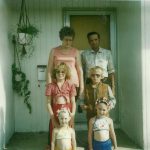
Later, after a fire burned most of the hotel down, the family moved to Winnemucca, Nevada, where Linda and Bobby both found work in the casinos. They really liked working there and also enjoyed gambling on their days off. I don’t know how they fared in their gambling, but they didn’t really spend a huge amount of time at it. They liked the warmth and easy winters, and enjoyed the place they had out in the country. It was quiet, and that was nice after the noise of the casinos.
My in-laws visited them periodically in their travels as snowbirds, and the sisters got to know each other again. For so many years they had lived far away from each 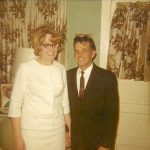 other, that they were more like acquaintances than sisters sometimes. The girls’ younger sister, Margee lives here in Casper. She and Linda talked on the telephone often, and they were very close. It was hard on the sisters to be so far away from Linda, but as time goes on, you get used to things.
other, that they were more like acquaintances than sisters sometimes. The girls’ younger sister, Margee lives here in Casper. She and Linda talked on the telephone often, and they were very close. It was hard on the sisters to be so far away from Linda, but as time goes on, you get used to things.
In May of 2014, Linda lost her husband, Bobby, and then Linda passed away in September of 2016. It had been a number of years since her sisters had seen Linda, and that made her passing especially sad. It always seemed as if there would be time, but when time ran out, it left only sadness where Linda had been. We can only look forward to seeing her again in Heaven. Today would have been Linda’s 73rd birthday. Happy birthday in Heaven, Linda. We love and miss you very much.
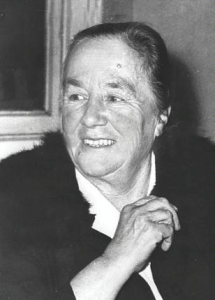 When Hitler began his reign of terror on the Jewish people, along with several other groups that he considered undesirables…the groups who were not of the “Aryan Race,” he proceeded to do unspeakable things to these poor people who could not fight back because they had no weapons. They were a peace-loving people who were just trying to get along with those around them, and those in power. Unfortunately, Hitler didn’t care if they were peace-loving, if they wanted to get along, or be cooperative. Their only crime was that they were not of the “Aryan Race.” For anyone who doesn’t really understand the concept of Aryan, it is this: “The Aryan race is a historical race concept which emerged in the period of the late 19th century and mid-20th century to describe people of Indo-European heritage as a racial grouping.”
When Hitler began his reign of terror on the Jewish people, along with several other groups that he considered undesirables…the groups who were not of the “Aryan Race,” he proceeded to do unspeakable things to these poor people who could not fight back because they had no weapons. They were a peace-loving people who were just trying to get along with those around them, and those in power. Unfortunately, Hitler didn’t care if they were peace-loving, if they wanted to get along, or be cooperative. Their only crime was that they were not of the “Aryan Race.” For anyone who doesn’t really understand the concept of Aryan, it is this: “The Aryan race is a historical race concept which emerged in the period of the late 19th century and mid-20th century to describe people of Indo-European heritage as a racial grouping.”
When Hitler, invaded Poland, he quickly began to turn people against the Jewish people. These people had been living as a part of a community, making an important contribution to Polish society. Hitler began by polluting the minds of the young people first, and then the older people against the Jewish people, saying that they were thieves, and that everything they owned rightfully belonged to the “Aryan” people. Many of the people bought into Hitler’s lies and hatred, but there were those who did not. The problem was that even those who did not agree to help the Jews, had to be careful, because if they didn’t turn in those who helped, it was considered harboring criminals. If they were caught helping the Jews, they could be sent to the work camps or executed.
Since the German invasion of Poland in 1939, the Jewish population had been either forced into ghettos, transported to concentration and labor camps, or murdered. Jewish homes and shops were confiscated and synagogues were burned to the ground. By 1942, things were getting really tough in Warsaw, but a group of Polish Christians refused to stand by and do nothing. So, they put their own lives at risk when they set up the Council for the Assistance of the Jews. The group was led by two women, Zofia Kossak and Wanda Filipowicz. Word about the Jews’ fate finally leaked out in June of 1942, when a Warsaw underground newspaper, the Liberty Brigade, made public the news that tens of thousands of Jews were being gassed at Chelmno, a death camp in Poland. It had been almost seven months since the extermination of prisoners had begun.
At first, people didn’t believe what they heard about the “Final Solution,” which was the mass extermination of European Jewry and the growing network of extermination camps in Poland. Soon, it was difficult to deny. Nevertheless, little was done to stop it. Angry speeches from politicians, followed by threats of postwar reprisals, were heard in places outside Poland. Within Poland, non-Jewish Poles were themselves often the objects of persecution and forced labor at the hands of their Nazi occupiers. Because they were Slavs, they too were considered “inferior” to the Aryan Germans, and therefore, only good as servants and slaves…according to the Nazis anyway. Zofia Kossak and Wanda Filipowicz didn’t care that they could lose their lives, what was going on, was wrong and they could not stand by and do nothing. These two Polish Christians were determined to do what they could to protect their Jewish neighbors.
History says that both women died in 1968, but it is unclear what caused Kossak and Filipowicz’s deaths. It is also unclear whether their mission was to protect the Polish Jews was successful. No matter what the outcome of their plan was, they did the right thing. They saw something that wasn’t right, and they tried to do something to correct the situation. Kossak and Filipowicz were not alone in their struggle to help either. Just two days after the Council was established, the SS, Hitler’s “political” terror police force, rounded up 23 men, 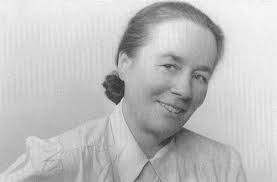 women, and children, and locked some in a cottage and some in a barn. Then they burned them alive. Their crime: suspicion of harboring Jews. They were not convicted or tried, they were just murdered.
women, and children, and locked some in a cottage and some in a barn. Then they burned them alive. Their crime: suspicion of harboring Jews. They were not convicted or tried, they were just murdered.
The Nazi death machine proved overwhelming, even with the bravery of some Polish Christians, and Jewish resistance fighters within the Warsaw ghetto, who rebelled in 1943. Some of the Polish Jews found refuge among their Christian neighbors, in an attempt to elude the SS. Poland became the killing ground for not only Poland’s Jewish citizens, but much of Europe’s as well…approximately 4.5 million Jews were killed in Poland’s death and labor camps by the end of World War II.
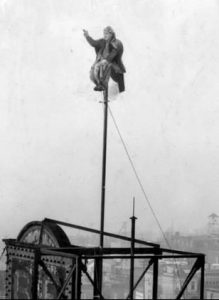 Alvin Kelly was born in Manhattan on May 11, 1893. His story began in a tragic way, because his father died before his birth and his mother died in childbirth with him. Kelly, now a newborn orphan, was raised in orphanages and passed around to various relatives. When Kelly turned 7, he started climbing onto poles and a few years later, he scaled the outside of buildings in his neighborhood…and by the way, his name wasn’t Alvin back then. It was Aloysius Anthony Kelly. He became Alvin when he ran away to go to work on a cargo ship. He was just 13 years old, and he changed his name to Alvin…probably to remain anonymous.
Alvin Kelly was born in Manhattan on May 11, 1893. His story began in a tragic way, because his father died before his birth and his mother died in childbirth with him. Kelly, now a newborn orphan, was raised in orphanages and passed around to various relatives. When Kelly turned 7, he started climbing onto poles and a few years later, he scaled the outside of buildings in his neighborhood…and by the way, his name wasn’t Alvin back then. It was Aloysius Anthony Kelly. He became Alvin when he ran away to go to work on a cargo ship. He was just 13 years old, and he changed his name to Alvin…probably to remain anonymous.
It wasn’t Kelly’s life as a runaway that made him unique, however, because runaways have existed for centuries. His childhood trick of climbing on poles stuck with him for the rest of his life. In fact, during the 1920s and 1930s, Kelly earned a name for himself…and a certain degree of notoriety…by sitting atop flag poles and other odd elevated perches for extended periods of time. I can’t imagine the purpose of such an act, and it’s not the most conventional way to fame, but for Alvin ‘Shipwreck’ Kelly it worked. Shipwreck Kelly, as he became known, is credited with starting the flagpole sitting fad, which, strangely, became popular in the Roaring Twenties, and he even earned a spot in the World Record Book for his sitting ability. I suppose an actor, comedian, magician, and such, needed a gimmick or a nickname, so Kelly began to use the nickname ‘Shipwreck’ claiming that he had survived the sinking of the Titanic. The story was proved to be untrue. Even then, Kelly claimed that he had many other close calls in his life. He said he had survived five shipwrecks, two plane crashes, three car accidents and one train derailment. In reality, Kelly most likely, acquired his nickname in the boxing ring. Not the greatest boxer, critics claimed he was often “adrift and ready to sink.”
As a teen and young man, Kelly hopped from job to job. His unusual ability to climb a pole and perch at the top did earn his work that he might not have otherwise been able to get. In addition to working at sea, he was a stunt pilot, movie double, steelworker, high diver, boxer, and a steeplejack. During World War I, Kelly was an ensign in the Naval Auxiliary Reserve, serving on the USS Edgar F. Luckenbach.
You might be wondering what started his Pole Sitting career. Well, like many a young man, Kelly was not one to back away from a dare. In 1924, he was dared by a friend to climb to the top of a flagpole in Philadelphia 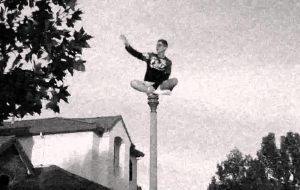 outside a local department store. Of course, Kelly jumped at the chance to prove himself. He quickly ascended the pole and perched himself on top. The stunt attracted a large crowd, many of whom then went inside to shop in the department store. The store manager asked Kelly to stay up there a while…it was good for business! Newspapers carried pictures of Kelly’s stunt, many daredevils began copying his stunt. A fad was born! Soon pole sitting was a popular trick and copycat sitters did it for laughs, on a dare, or to protest. Even though so many others were doing it now, Kelly, the original pole sitter, continued his stunts to the delight of onlookers and journalists. Everyone knew he was the original, and the others were merely copycats.
outside a local department store. Of course, Kelly jumped at the chance to prove himself. He quickly ascended the pole and perched himself on top. The stunt attracted a large crowd, many of whom then went inside to shop in the department store. The store manager asked Kelly to stay up there a while…it was good for business! Newspapers carried pictures of Kelly’s stunt, many daredevils began copying his stunt. A fad was born! Soon pole sitting was a popular trick and copycat sitters did it for laughs, on a dare, or to protest. Even though so many others were doing it now, Kelly, the original pole sitter, continued his stunts to the delight of onlookers and journalists. Everyone knew he was the original, and the others were merely copycats.
Never content, Kelly continued to look for ways to outdo his latest tricks. In 1926 in Saint Louis, he stayed perched atop a pole for seven days and one hour. The next year, in June of 1927 in Newark, New Jersey, he extended his record to twelve days. Next, it was a 23 day sit on a flagpole in Carlin’s Park in Baltimore in 1929. His final record was set in 1930 when he stayed on a flagpole on Atlantic City’s Steel Pier for 49 days and one hour. I don’t know about you, but I can’t begin to imagine such extended days sitting on a flagpole. Nevertheless, for Kelly, it seemed to be a normal part of his daily routine. Newspapers of the 1920s loved to feature photographs of Kelly “sitting high in the air, especially ones of him doing everyday things, like shaving or reading a newspaper or brushing his teeth. During his sits, Kelly rarely ate, sustaining himself on coffee and cigarettes. Although he used a leg tether as a safeguard against falling, He learned to sleep sitting upright and he explained that he slept with his thumbs stuck in holes in the pole. If he started to lean one way or the other in his sleep, the pain in his thumbs would wake him in time for him to right himself.”
Kelly toured across the country during the peak of his fame, and charged admission for people to see him sitting on a flagpole. I would find watching someone sit on a pole would be boring, but people did. He once estimated that he spent 20,613 hours sitting on flag poles in his lifetime, including about 1,400 hours in 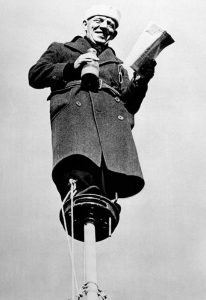 pouring down rain and 210 hours in sub-freezing temperatures. He was often hired to do publicity stunts because business owners knew he could draw a crowd. For example, on October 13, 1939, Kelly was hired to promote National Donut Dunking Week by sitting on a pole in Manhattan and eating 13 donuts dipped in coffee. I wonder how much they paid him for that stunt.
pouring down rain and 210 hours in sub-freezing temperatures. He was often hired to do publicity stunts because business owners knew he could draw a crowd. For example, on October 13, 1939, Kelly was hired to promote National Donut Dunking Week by sitting on a pole in Manhattan and eating 13 donuts dipped in coffee. I wonder how much they paid him for that stunt.
As the Great Depression of the 1930s progressed, people became less interested in Kelly’s tricks…and less tolerant. In 1935, he attempted to break his own record again, but the Bronx police said he was creating a public nuisance. The police threatened to chop down his pole, if he didn’t come down and when he did, he was promptly arrested. His last attempt at pole sitting was in Orange, Texas, in 1952. That day, while sitting on the pole, Kelly suffered two heart attacks and was forced to come down. He announced his retirement from pole sitting and died a week later.
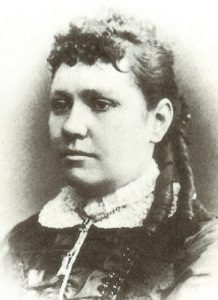 Alice Ivers Tubbs was born in Devonshire, England on February 17, 1851. She was the daughter of a conservative schoolmaster. While Alice was still a small girl, she moved with her family to the United States. The family first settled in Virginia, where Alice attended an elite boarding school for women. When she was a teenager, the family moved with the silver rush to Leadville, Colorado. As a young girl, Alice was raised to be a well-bred young lady, so few people would ever expect her to be known as “Poker Alice.” Nevertheless, marriage can change a person. While living in Leadville, Alice met a mining engineer named Frank Duffield, whom she married when she was just 20 years old. In the mining camps, gambling’s was quite common, and Frank was an enthusiastic player. He enjoyed visiting the gambling halls in Leadville and Alice naturally went along with him, rather than staying home alone. Alice stood quietly and watch her husband play…at first, but Alice was smart, and she picked up the game of poker easily. Soon she was sitting in on the games, and she was winning. Alice’s marriage to Frank Duffield was short-lived. Duffield, who worked in the mines as part of his job, was killed in an explosion. Needing to make a living, Alice, who was well educated, could have taught school, but even with 35,000 residents in Leadville, there was no school. There were also few jobs available for women, and those there were, did not appeal to Alice, so she decided to make a living gambling. Though Alice preferred the game of poker, she also learned to deal and play Faro. Very soon, she was in high demand…as a player and a dealer. Alice was a petite 5 foot 4 inch beauty, with blue eyes and thick brown hair. She was very rare in that she was a “lady” in a gambling hall…and not of the “soiled dove” variety. And Alice loved the latest fashions, she was a sight for the sore eyes of many a miner. Every time Alice had a big win, she began to take trips to New York City to buy the latest fashions.
Alice Ivers Tubbs was born in Devonshire, England on February 17, 1851. She was the daughter of a conservative schoolmaster. While Alice was still a small girl, she moved with her family to the United States. The family first settled in Virginia, where Alice attended an elite boarding school for women. When she was a teenager, the family moved with the silver rush to Leadville, Colorado. As a young girl, Alice was raised to be a well-bred young lady, so few people would ever expect her to be known as “Poker Alice.” Nevertheless, marriage can change a person. While living in Leadville, Alice met a mining engineer named Frank Duffield, whom she married when she was just 20 years old. In the mining camps, gambling’s was quite common, and Frank was an enthusiastic player. He enjoyed visiting the gambling halls in Leadville and Alice naturally went along with him, rather than staying home alone. Alice stood quietly and watch her husband play…at first, but Alice was smart, and she picked up the game of poker easily. Soon she was sitting in on the games, and she was winning. Alice’s marriage to Frank Duffield was short-lived. Duffield, who worked in the mines as part of his job, was killed in an explosion. Needing to make a living, Alice, who was well educated, could have taught school, but even with 35,000 residents in Leadville, there was no school. There were also few jobs available for women, and those there were, did not appeal to Alice, so she decided to make a living gambling. Though Alice preferred the game of poker, she also learned to deal and play Faro. Very soon, she was in high demand…as a player and a dealer. Alice was a petite 5 foot 4 inch beauty, with blue eyes and thick brown hair. She was very rare in that she was a “lady” in a gambling hall…and not of the “soiled dove” variety. And Alice loved the latest fashions, she was a sight for the sore eyes of many a miner. Every time Alice had a big win, she began to take trips to New York City to buy the latest fashions.
Due to her traveling from one mining camp to another to play poker, Alice soon acquired the nickname “Poker Alice.” In addition to playing the game, she often worked as a dealer, in cities all over Colorado including Alamosa, Central City, Georgetown, and Trinidad. Later on, Alice began to puff on large black cigars, still wearing her fashionable frilly dresses. She, nevertheless, never gambled on Sundays because of her religious beliefs. Alice carried a .38 revolver and wasn’t afraid to use it. It was rather a necessity, due to her lifestyle. Alice soon left Colorado and made her way to Silver City, New Mexico, where she broke the bank at the Gold Dust Gambling House, winning some $6,000. The win was followed by a trip to New York City, to replenish her wardrobe of fashionable clothing. Afterward, she returned to Creede, Colorado. She went to work as a dealer in Bob Ford’s saloon…the man who had earlier killed Jesse James. Alice later moved to Deadwood, South Dakota around 1890. In Deadwood, she met a man named Warren G. Tubbs, who worked as a housepainter in Sturgis, but sidelined as a dealer and 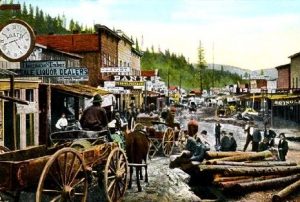 gambler. Alice usually beat Tubbs at poker, but that didn’t bother him. He was taken with her and they began to see each other socially. Once a drunken miner threatened Tubbs with a knife, Alice pulled out her .38 and put a bullet into the miner’s arm. I’m sure that man thought the threat was Tubbs, but the man should have watched Alice in stead. Later, the couple married and had seven children…four sons and three daughters. Because Tubbs was a painter by trade, he, along with Alice’s gambling profits, supported the family. The family moved out of Deadwood, to homesteaded a ranch near Sturgis on the Moreau River. Finally, Alice found something she loved more than gambling…for the most part. She helped with the ranch and raised her children. Then, fate would again deal Alice a bad hand. Tubbs was diagnosed with tuberculosis. Alice refused to leave his side. She planned to nurse him back to health. Tubbs lost his fight, and died of pneumonia in the winter of 1910. Alice was determined to give him a proper burial, so she loaded him into a horse-drawn wagon to take his body to Sturgis. It is thought that she had to pawn her wedding ring to pay for the funeral and afterward, went to a gambling parlor to earn the money to get her ring back.
gambler. Alice usually beat Tubbs at poker, but that didn’t bother him. He was taken with her and they began to see each other socially. Once a drunken miner threatened Tubbs with a knife, Alice pulled out her .38 and put a bullet into the miner’s arm. I’m sure that man thought the threat was Tubbs, but the man should have watched Alice in stead. Later, the couple married and had seven children…four sons and three daughters. Because Tubbs was a painter by trade, he, along with Alice’s gambling profits, supported the family. The family moved out of Deadwood, to homesteaded a ranch near Sturgis on the Moreau River. Finally, Alice found something she loved more than gambling…for the most part. She helped with the ranch and raised her children. Then, fate would again deal Alice a bad hand. Tubbs was diagnosed with tuberculosis. Alice refused to leave his side. She planned to nurse him back to health. Tubbs lost his fight, and died of pneumonia in the winter of 1910. Alice was determined to give him a proper burial, so she loaded him into a horse-drawn wagon to take his body to Sturgis. It is thought that she had to pawn her wedding ring to pay for the funeral and afterward, went to a gambling parlor to earn the money to get her ring back.
For Alice, the time spent on the ranch were some of the happiest days of her life and that during those years, she didn’t miss the saloons and gambling halls. Alice liked the peace and quiet of the ranch. Still, she had to make a living, so after Tubbs’ death, she hired a man named George Huckert to take care of the homestead, and she moved to Sturgis to earn her way. Huckert quickly fell in love with Alice and proposed marriage to her several times. Alice didn’t really love him, but finally married him, saying flippantly, “I owed him so much in back wages; I figured it would be cheaper to marry him than pay him off. So I did.” Once again, the marriage would be short. Alice was widowed once again when Huckert died in 1913.
During the Prohibition years, Alice opened a saloon called “Poker’s Palace” between Sturgis and Fort Meade that provided not only gambling and liquor, but also “women” who serviced the customers. One night, a drunken soldier began a fight in the saloon. He was destroying the furniture, and causing a ruckus. Alice pulled her .38 and shot the man. While in jail awaiting trial, she calmly smoked cigars and read the Bible. She was acquitted on grounds of self-defense, but her saloon had been shut down. Now, in her 70s and with her beauty and fashionable gowns long gone, Alice struggled in her last years. She continued to gamble, but these days, she dressed in men’s clothing. Once in a while, she was featured at  events like the Diamond Jubilee, in Omaha, Nebraska, as a true frontier character, where she was known to have said, “At my age, I suppose I should be knitting. But I would rather play poker with five or six ‘experts’ than eat.” She continued to run a “house” of ill-repute in Sturgis during her later years and was often arrested for drunkenness and keeping a disorderly house. Though she paid her fines, she continued to operate the business until she was finally arrested for repeated convictions of running a brothel and sentenced to prison. The governor took pity on Alice, who was then 75 years old, and pardoned her. At the age of 79, Alice underwent a gall bladder operation in Rapid City. Unfortunately, she died of complications on February 27, 1930. She was buried at Saint Aloysius Cemetery in Sturgis, South Dakota. In her lifetime, Alice claimed to have “won more than $250,000 at the gaming tables and never once cheated.” In fact, one of her favorite sayings was, “Praise the Lord and place your bets. I’ll take your money with no regrets.”
events like the Diamond Jubilee, in Omaha, Nebraska, as a true frontier character, where she was known to have said, “At my age, I suppose I should be knitting. But I would rather play poker with five or six ‘experts’ than eat.” She continued to run a “house” of ill-repute in Sturgis during her later years and was often arrested for drunkenness and keeping a disorderly house. Though she paid her fines, she continued to operate the business until she was finally arrested for repeated convictions of running a brothel and sentenced to prison. The governor took pity on Alice, who was then 75 years old, and pardoned her. At the age of 79, Alice underwent a gall bladder operation in Rapid City. Unfortunately, she died of complications on February 27, 1930. She was buried at Saint Aloysius Cemetery in Sturgis, South Dakota. In her lifetime, Alice claimed to have “won more than $250,000 at the gaming tables and never once cheated.” In fact, one of her favorite sayings was, “Praise the Lord and place your bets. I’ll take your money with no regrets.”
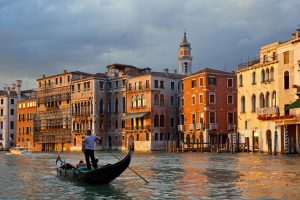 When people think of Venice, Italy, they think of the canals and the boats. I think most of us think the city is pretty much streets of water, and buildings that somehow stand in the water…strong and immovable against the water. Venice is the center of the lagoon of Venice, which extends over a length of 25 miles around the city. While it seems like the city is covered in water, only 11% of the lagoon is permanently covered with water, while the rest of the lagoon is islands or mudflats and marshes (Laguna Morta). The water stays fresh because, seawater from the Adriatic flows into the lagoon through three large passages, Bocca di Lido, Bocca di Malamocco, and Bocca di Chioggia, twice daily. This process provides a natural water exchange. Still, 11% water can sure look like a lot, especially when every touristy picture we see involves the canals and gondolas. So, to think of a situation whereby a flood could become tragic in Venice, is a strange thought for anyone who doesn’t really know Venice…like me.
When people think of Venice, Italy, they think of the canals and the boats. I think most of us think the city is pretty much streets of water, and buildings that somehow stand in the water…strong and immovable against the water. Venice is the center of the lagoon of Venice, which extends over a length of 25 miles around the city. While it seems like the city is covered in water, only 11% of the lagoon is permanently covered with water, while the rest of the lagoon is islands or mudflats and marshes (Laguna Morta). The water stays fresh because, seawater from the Adriatic flows into the lagoon through three large passages, Bocca di Lido, Bocca di Malamocco, and Bocca di Chioggia, twice daily. This process provides a natural water exchange. Still, 11% water can sure look like a lot, especially when every touristy picture we see involves the canals and gondolas. So, to think of a situation whereby a flood could become tragic in Venice, is a strange thought for anyone who doesn’t really know Venice…like me.
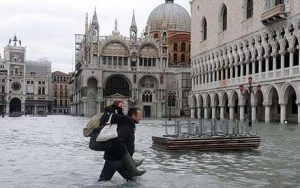
On December 1, 2008, Venice experienced the biggest flood in more than twenty years. The waters rose more than five feet above normal levels. As with any flood, many of Venice’s streets, including Saint Mark’s Square, were submerged. Venice has flooding for about two hundred days every year, and the Venetian authorities were working to complete an underwater dam by 2011. Unfortunately, that fact didn’t help the city in 2008. Even with unusually high tides because of the new moon, residents were not surprised to see the usual low-lying lanes under water. Nevertheless, this day was different. Pretty much the entire city was covered by the lagoon. People stayed inside to wait out the water, only going outside when they were sure the water was definitely going down. The townspeople went outside to take pictures and explore the current townscape…to see what was underwater now. They were quite surprised at the scene before them.
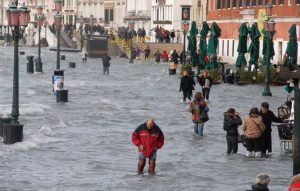
By mid-afternoon, the water had gone down to more normal levels, but all over the world, the papers made it seem like the whole city was sinking. The high tide would come again on December 2nd, but it was nothing like December 1st. Cleanup was still underway on December 2nd, of course, but most businesses were open again. I suppose that if your city spends it’s life in one stage of flood or another, this extra high tide was just something to be taken in stride. Yes, people were surprised at the higher than normal flood waters from the tide, but they weren’t panicked. It was just another day in the life of Venice.

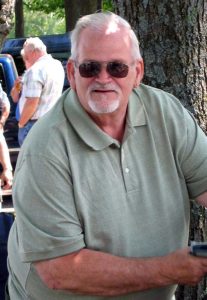 The ship, SS Daniel J. Morrell was a 603 foot Great Lakes freighter, first launched August 22, 1906. It was operated by Cambria Steamship Company. The freighter was used to carry bulk cargoes such as iron ore. SS Daniel J. Morrell was named for Daniel Johnson Morrell, a Republican member of the US House of Representatives from Pennsylvania. In 1855 he moved to Johnstown, Pennsylvania, and became general manager of the Cambria Iron Company, which was the greatest manufacturer of iron and steel in the United States until the Johnstown Flood. As a former general manager of Cambria Steamship Company…Morrell died August 20, 1885…naming the ship after him made sense.
The ship, SS Daniel J. Morrell was a 603 foot Great Lakes freighter, first launched August 22, 1906. It was operated by Cambria Steamship Company. The freighter was used to carry bulk cargoes such as iron ore. SS Daniel J. Morrell was named for Daniel Johnson Morrell, a Republican member of the US House of Representatives from Pennsylvania. In 1855 he moved to Johnstown, Pennsylvania, and became general manager of the Cambria Iron Company, which was the greatest manufacturer of iron and steel in the United States until the Johnstown Flood. As a former general manager of Cambria Steamship Company…Morrell died August 20, 1885…naming the ship after him made sense.
SS Daniel J. Morrell, along with her sister ship, SS Edward Y. Townsend were making the last run of the season. On November 29, 1966, they encountered a storm with winds exceeding 70 miles per hour and swells that topped the height of the ship, at 20 to 25 feet. Edward Y. Townsend decided to take shelter in the St. Clair River. That left Daniel J. Morrell alone on the waters north of Pointe Aux Barques, Michigan, heading for the protection of Thunder Bay. As the storm grew worse, and at 2:00pm, the Morrell began to break up, which forced the crew onto the deck. Many of the crew panicked and jumped to their deaths in the 34° Lake Huron waters. At 2:15pm, the ship’s hull broke and allowed water to pour in, and the remaining crewmen loaded into a raft on the bow of the vessel. While they waited for the ship to break up and the raft to be thrown into the lake, there were shouts that a ship had been spotted off the port bow. Unfortunately, moments later, it became clear that 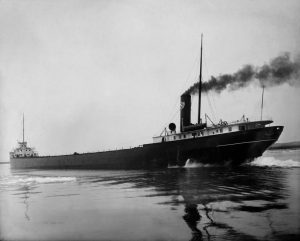 the looming object was not another ship, but Daniel J. Morrell’s aft section, barreling towards them under the power of the ship’s engine. The ship broke apart, throwing the rafts into the water heading into the distance.
the looming object was not another ship, but Daniel J. Morrell’s aft section, barreling towards them under the power of the ship’s engine. The ship broke apart, throwing the rafts into the water heading into the distance.
Tragically, Daniel J. Morrell was not reported missing until 12:15pm the following afternoon, November 30th. By then, the vessel was overdue at her destination, Taconite Harbor, Minnesota. The US Coast Guard issued a “be on the lookout” alert and dispatched several vessels and aircraft to search for the missing freighter. At around 4:00pm on November 30th, a Coast Guard helicopter located the lone survivor, 26-year-old Watchman Dennis Hale, near frozen and floating in a life raft with the bodies of three of his crewmates. Hale had survived the nearly 40 hour ordeal in frigid temperatures wearing only a pair of boxer shorts, a lifejacket, and a pea coat. Since his crewmates had passed away, poor Hale was left alone with his thoughts…trying to avoid thinking about the cold bodies lying next to him. The survey of the wreck found the shipwreck in 220 feet of water with the two sections 5 miles apart.
Lost in the tragic sinking were Norman M. Bragg, Stuart A. Campbell, John J. Cleary Jr, Arthur I. Crawley, George A. Dahl, Larry G. Davis, Arthur S. Fargo, Charles H. Fosbender, Saverio Grippi, John M. Groh (missing),  Nicholas P. Homick, Phillip E. Kapets, Chester Konieczka, Duncan R. MacLeod, Joseph A. Mahsem, Valmour A. Marchildon, Ernest G. Marcotte, Alfred G. Norkunas, David L. Price, Henry Rischmiller, Stanley J. Satlawa (missing), John H. Schmidt, Charles J. Sestakauskas, Wilson E. Simpson, Arthur E. Stojek, Leon R. Truman, Albert P. Wieme, and Donald E. Worcester. The remains of 26 of the 28 lost crewmen were eventually recovered, with most of them found in the days following the sinking. Still, bodies from Daniel J. Morrell continued to be found well into May of the following year. The two men whose bodies were never recovered were declared legally dead in May 1967. The sole survivor of the sinking, Dennis Hale, died of cancer on September 2, 2015, at the age of 75.
Nicholas P. Homick, Phillip E. Kapets, Chester Konieczka, Duncan R. MacLeod, Joseph A. Mahsem, Valmour A. Marchildon, Ernest G. Marcotte, Alfred G. Norkunas, David L. Price, Henry Rischmiller, Stanley J. Satlawa (missing), John H. Schmidt, Charles J. Sestakauskas, Wilson E. Simpson, Arthur E. Stojek, Leon R. Truman, Albert P. Wieme, and Donald E. Worcester. The remains of 26 of the 28 lost crewmen were eventually recovered, with most of them found in the days following the sinking. Still, bodies from Daniel J. Morrell continued to be found well into May of the following year. The two men whose bodies were never recovered were declared legally dead in May 1967. The sole survivor of the sinking, Dennis Hale, died of cancer on September 2, 2015, at the age of 75.

 Very early this morning, a beautiful lady went to Heaven. Aunt Virginia Beadle was first and foremost a mother to her children. She loved each and every one of them so much, and always considered herself to be very blessed by her children and later her children’s spouses. She enjoyed every one of her grandchildren, and her last granddaughter was named after the daughter Aunt Virginia lost in 1967…Christy. Aunt Virginia loved children…of all ages. In her early live, she and her first husband adopted a son, Forrest, and she loved him dearly. He passed away in 2005, and the loss was devastating to her. After the loss of these two children, she focused her life on the rest of her kids, and any others that she could help. She was truly a great woman, often known by those she helped as the “patron saint of lost children.” Over the years, she took in so many kids. It didn’t matter what their need was. They might be troubled, drugged out, or lost…it didn’t matter to her. She was there to help in any way she could. She always looked for the good in people, and I don’t know of anyone in whom she could find no good. Those who knew her, her kids, grandkids, and her nieces and nephews loved her dearly. My cousin Elmer Johnson spent time with her when he could over the years…probably more than most of the nieces and nephews did. When he lost his own parents, Elmer and Delores Johnson, I’m sure she was there to help ease the pain. That
Very early this morning, a beautiful lady went to Heaven. Aunt Virginia Beadle was first and foremost a mother to her children. She loved each and every one of them so much, and always considered herself to be very blessed by her children and later her children’s spouses. She enjoyed every one of her grandchildren, and her last granddaughter was named after the daughter Aunt Virginia lost in 1967…Christy. Aunt Virginia loved children…of all ages. In her early live, she and her first husband adopted a son, Forrest, and she loved him dearly. He passed away in 2005, and the loss was devastating to her. After the loss of these two children, she focused her life on the rest of her kids, and any others that she could help. She was truly a great woman, often known by those she helped as the “patron saint of lost children.” Over the years, she took in so many kids. It didn’t matter what their need was. They might be troubled, drugged out, or lost…it didn’t matter to her. She was there to help in any way she could. She always looked for the good in people, and I don’t know of anyone in whom she could find no good. Those who knew her, her kids, grandkids, and her nieces and nephews loved her dearly. My cousin Elmer Johnson spent time with her when he could over the years…probably more than most of the nieces and nephews did. When he lost his own parents, Elmer and Delores Johnson, I’m sure she was there to help ease the pain. That 

 was the kind of woman Aunt Virginia always was.
was the kind of woman Aunt Virginia always was.
Aunt Virginia’s latter years were spent surrounded by her family, living until recently with her son, Steve and his wife, Wanda. There, her family gathered to spend quality time with their mom, and dad, until Bill’s passing on January 17, 2018. There, her sons Steve and Billy, with their families, and her daughter, Betsy, with her children, and her grandchildren talked, laughed, and even cried with their mom as she went through the last days of her life. Most recently, Aunt Virginia needed full-time care, so it was decided that she would move in with Billy and his wife, Janie, who did not work outside the home. That meant that Janie could care for Aunt Virginia’s more full-time needs. Aunt Virginia said of her children and their spouses, “I have been so lucky.” I don’t think is was luck, however. I think that her children and their spouses are simply amazing people who loved their mom/mother-in-law very much, and who would do anything for her.
As my cousin Elmer pointed out to me today, now Aunt Virginia gets to reunite with Bill; her son, Forrest and 
 daughter, Christy; her sisters, Evelyn, Delores, and Collene; her brother, Larry; and brothers-in-law, George, Elmer, Allen, and Jack; and of course, her parents, George and Hattie. She leaves behind some good kids and so many she helped to turn their lives around, and for that, she will forever be remembered. Aunt Virginia’s life was full and she was and is loved by all those she touched. No matter how tough things were for her, she would give the shirt off her back to anyone who needed it. That was just the kind of woman she was…a tough one, for sure. Rest in peace now Aunt Virginia. We will love and miss you always.
daughter, Christy; her sisters, Evelyn, Delores, and Collene; her brother, Larry; and brothers-in-law, George, Elmer, Allen, and Jack; and of course, her parents, George and Hattie. She leaves behind some good kids and so many she helped to turn their lives around, and for that, she will forever be remembered. Aunt Virginia’s life was full and she was and is loved by all those she touched. No matter how tough things were for her, she would give the shirt off her back to anyone who needed it. That was just the kind of woman she was…a tough one, for sure. Rest in peace now Aunt Virginia. We will love and miss you always.

 My grand-nephew, Nick Olsen, who joined our family, when he married my grand-niece, Siara Harman, is truly right where he should be. I think he was destined to be a husband and father, and now, with the recent birth of his sweet Alec Todd Olsen…Nick and Siara are parents. Nick is a wonderful daddy to little Alec, and can often be seen holding him, and the picture is beautiful. Alec loves his daddy so much, even at this early stage in his life. Both Alec and Siara feel very blessed to have Nick in their lives, and he feels blessed to have them in his.
My grand-nephew, Nick Olsen, who joined our family, when he married my grand-niece, Siara Harman, is truly right where he should be. I think he was destined to be a husband and father, and now, with the recent birth of his sweet Alec Todd Olsen…Nick and Siara are parents. Nick is a wonderful daddy to little Alec, and can often be seen holding him, and the picture is beautiful. Alec loves his daddy so much, even at this early stage in his life. Both Alec and Siara feel very blessed to have Nick in their lives, and he feels blessed to have them in his.
Nick is a quiet man. That’s ok, because his face shows his feelings very well. When Nick looks at Siara, you can see how much he loves his beautiful bride. And when Nick looks at Alec, you can see the great love he has for him and the joy he feels from being a daddy. Not every man has such an expressive face, but Nick certainly does. Or maybe, a lot of men mask their faces, so you can’t see how they feel. I think that it’s very sweet that Nick expresses his feelings like that. I think Siara likes it too.
Nick and Siara make such a cute couple. He is very tall, and she is very short. I think they both knew from the day they met, that they would be together for the rest of their lives. Nick is the type of man who will always be 
 there for his family. He will protect them, provide for them, and love them for all time. It is written all over his face. Siara and Alec are very blessed to have him.
there for his family. He will protect them, provide for them, and love them for all time. It is written all over his face. Siara and Alec are very blessed to have him.
Nick is a Seattle Seahawks fan, while Siara is a Pittsburgh Steelers fan. Since they are both very into football, I suppose that could get to be a battle of the rivals, although I don’t think these two teams are arch rivals. It makes me wonder if little Alec will follow his daddy’s team or his mommy’s team. I suppose he will root for both for a while, because it is my guess that he will love to watch the games as much as his parents do. For Nick, I’m sure this will become another father/son bonding moment, and that is very cool. Nick’s future is bright indeed. Today is Nick’s birthday. Happy birthday Nick!! Have a great day!! We love you!!
 It’s that time of year again, and Thanksgiving Day has arrived. The day will begin with much cooking, table setting, and other preparation. All too often we get so caught up in the preparation for the main meal of the day, and prepare for the gathering together of family and friends, that we forget the real purpose of the day…giving thanks for all we have been given.
It’s that time of year again, and Thanksgiving Day has arrived. The day will begin with much cooking, table setting, and other preparation. All too often we get so caught up in the preparation for the main meal of the day, and prepare for the gathering together of family and friends, that we forget the real purpose of the day…giving thanks for all we have been given.
Over the past year, some health issues have presented themselves, not only in our family, with my husband, Bob; but with my son-in-law, Kevin’s mother, Becky Skelton too. Both of them had heart issues, and now both of them are well again. You can’t emphasize too much, the importance of good health. Never is that importance made more clear, than when things happen that threaten that good health. The concerns we have all felt, each of us watching as another of our loved ones has worried over their mom or dad, husband or wife, brother or sister, were almost overwhelming. Now, that all the tests, the surgery, the procedure, and the recovery are behind us, we feel only thankfulness.
Our daughter, Corrie has been working hard in nursing school, and doing very well. She has been so blessed 
 with great grades, and a wonderful nursing school experience. I have watched her blossom throughout this process, and it warms my heart to see such an amazing transformation in her. She and Kevin have also been blessed with a granddaughter, who is their son, Chris and fiancée, Karen’s daughter. Their son Josh is very busy with two jobs, while waiting for the next college class that he needs to become an EMT. Eventually he will be going into firefighting.
with great grades, and a wonderful nursing school experience. I have watched her blossom throughout this process, and it warms my heart to see such an amazing transformation in her. She and Kevin have also been blessed with a granddaughter, who is their son, Chris and fiancée, Karen’s daughter. Their son Josh is very busy with two jobs, while waiting for the next college class that he needs to become an EMT. Eventually he will be going into firefighting.
Bob and I have been thankful to have been able to travel to visit our daughter Amy Royce and her family, and spend two weeks with them, including Independence Day, which was a new thing for us, since we have spent Independence Day in the Black Hills for many years. Spending quality time with Amy; Travis; Shai and her boyfriend, Jordan; and Caalab, and his girlfriend, Chloe, was a special time. Any amount of time spent with family is something to be thankful for. As our children, grandchildren, and now great granddaughter grow and become more busy, time is something that is often in short supply, and definitely a blessing.


Everyone has different reasons to be thankful all year long, but at this time of year, we tend to reflect on the many blessings we have been given all year…some are extra special, and others bring deep emotion, because we know what we might have lost. This Thanksgiving Day, I realize just how much I have to be thankful for, and for all of it, I thank God, the Father of Lights, from whom all good gifts come. I hope everyone has as much to be thankful for as I have this year. Happy Thanksgiving to all.

 I was talking with my sister-in-law, Brenda Schulenberg yesterday, and she mentioned that our niece, Machelle Moore had only had 6 times in her life that Thanksgiving had fallen on her birthday. Having a late November birthday, one might expect to have a Thanksgiving birthday more often, but because her birthday was very late in the month, that is just not the case.
I was talking with my sister-in-law, Brenda Schulenberg yesterday, and she mentioned that our niece, Machelle Moore had only had 6 times in her life that Thanksgiving had fallen on her birthday. Having a late November birthday, one might expect to have a Thanksgiving birthday more often, but because her birthday was very late in the month, that is just not the case.
Thinking back on Machelle’s life, I recall that she was born three days after Thanksgiving in 1976. Bob and I had taken our girls to visit his aunt and uncle in Kennebec, South Dakota, and the weather had turned bad. I don’t recall if we had to spend an extra day or not, but I do remember that Machelle’s mom, Debbie Cook went into labor and after about 36 hours of labor, had to have a Caesarean Section for Machelle to be delivered. It was a bit scary, but in the end, we went home to meet our new little 
 niece. She was born 6 months after my Amy and 18 months after my Corrie, so the girls were always good friends.
niece. She was born 6 months after my Amy and 18 months after my Corrie, so the girls were always good friends.
Machelle has changed so much over the years. Not only has she grown tall like her dad, LJ Cook, but she has grown sweeter every year. Machelle has a kind heart. I don’t know anyone who doesn’t love her very much. She is a wife to her best friend, Steve Moore. They love each other so much, and are very well suited to each other. They both love to go rock hunting, and often come back with great pieces of obsidian that Steve turns into Native American tools that are beautiful…and the real shock is that Steve isn’t Native American. It’s a cool passion that Machelle and her husband share.
Machelle is also mom to two boys, Weston and Easton, who are almost grown men now. Weston has graduated from high school, and Easton is in high school. As the boys have grown, Machelle feels a little bit sad, because  she knows that soon they will be out on their own and she will be an empty nester, like so many others who have gone before her into that new identity. For some it is difficult and for others it is easy…or at least not as hard as for others. I think Machelle will do fine, because she has a wonderful marriage. She and Steve share so many interests, including camping, rock hunting, and the company of good friends and family. Yes, I know that Machelle and Steve will have a long wonderful life together, and before she knows it, daughters-in-law and grandchildren. I’m sure she is not in a huge hurry to get there, but it is a nice dream of the future. Today is Machelle’s birthday. Happy birthday Machelle!! Have a great day!! We love you!!
she knows that soon they will be out on their own and she will be an empty nester, like so many others who have gone before her into that new identity. For some it is difficult and for others it is easy…or at least not as hard as for others. I think Machelle will do fine, because she has a wonderful marriage. She and Steve share so many interests, including camping, rock hunting, and the company of good friends and family. Yes, I know that Machelle and Steve will have a long wonderful life together, and before she knows it, daughters-in-law and grandchildren. I’m sure she is not in a huge hurry to get there, but it is a nice dream of the future. Today is Machelle’s birthday. Happy birthday Machelle!! Have a great day!! We love you!!

